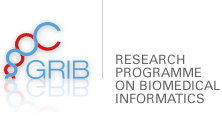
23/12/2010
"'To be or not to be, that is the question': The role of the ZRF1 gene in embryonic and cancer development"
The work, published in the journal Nature, was led by the ICREA professor Luciano Di Croce (CRG), with the participation of Núria López-Bigas and Gunes Gundem, head and predoctoral research respectively of the Biomedical Genomics laboratory of GRIB (IMIM/ UPF) and shows that the gene ZRF1 carries out a crucial role in the activation of genes related to the cellular destination of stem cells.
“To be or not to be, that is the question”… During embryonic development, cells undergoing multiplication have to decide what type of cells they will become. For example, they have to decide whether they will be neuronal, muscular, or epidermal cells. At this point, it is as important for the cell to understand what it should become as what it should not become and therefore a tight control of gene expression is required. In order to coordinate and direct the destined of the stem cells, certain genes are responsible for activating and deactivating other genes that define their specialty during development and that also may be involved in cellular renewal for tissue and organ maintenance.
As described in the work published in Nature, ZRF1 is one of the genes that coordinate this regulation in embryonic development. The work has been done by the “Epigenetic events in cancer” group, lead by Luciano Di Croce at the Center of Genomic Regulation, in collaboration with Núria Lopez from the Pompeu Fabra University and scientists from the Nagasaki University School of Medicine and the Freiburg University.
“We know that ZARF is present at high levels in cells during their development as well as in altered cancer cells. Now for the first time we understand that their presence is essential for controlling cellular destiny and memory”, commented Di Croce. He also explained, “When ZRF1 is active, the proteins that block transcription of the genes that determine the destiny of the cells are removed. This allows the cells to begin on their path towards specialization”.
If the gears that control the cellular destiny no longer function, this unleashes problems in the cell since it is converted to a uncontrolled cell. “Now that we know why ZRF1 is important, we would like to identify the specific genes that are being controlled to see in which part of the genome they are located” explained Holger Richly, the first author of the study. This would permit the researchers to identify further genes that may be involved in the differentiation process. “Understanding in detail the gene that we are studying would open up good perspectives to better understanding the processes of tumor formation and carcinogenesis in the long run. ZARF is a highly conserved gene that is found in a large variety of organisms, from yeast to mammals, which makes it a perfect candidate for investigating these processes” added Di Croce.
The project was financed by the Minister of Science and Innovation through the Plan Nacional de Investigación, Desarrollo e Innovación and by the Association for International Cancer Research.
Publication Reference: Richly H, Rocha-Viegas L, Domingues Ribeiro J, Semajo S, Gundem G, López-Bigas N, Nakagawa T, Rospert S, Takashi I and Di Croce L. (2010). “Transcriptional activation of polycomb-repressed genes by ZRF1” Nature. DOI: 10.1038/nature09574



